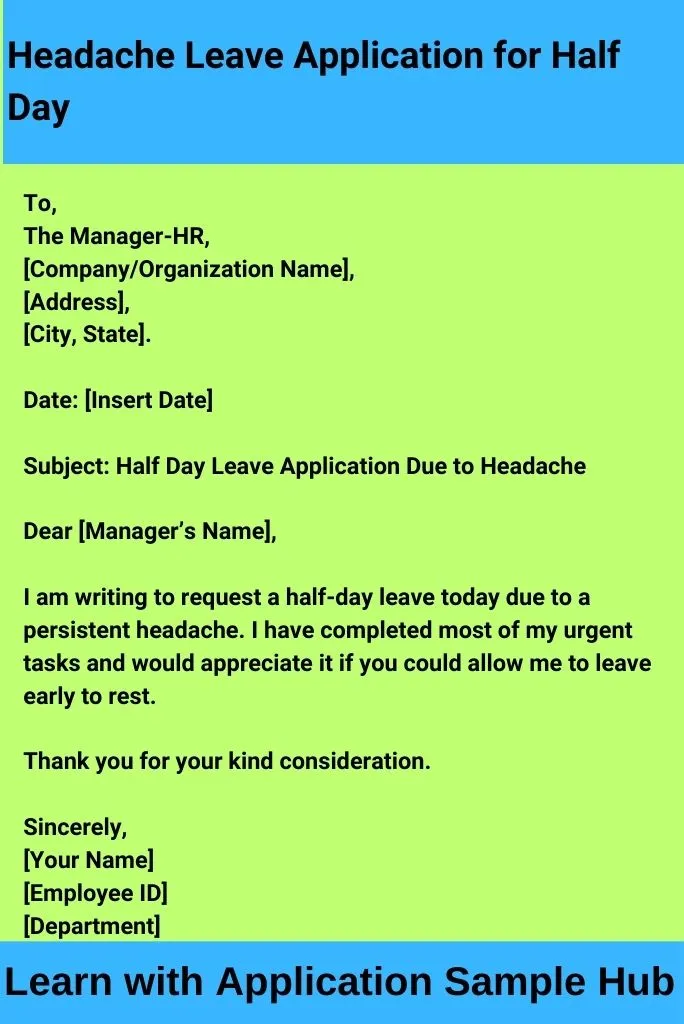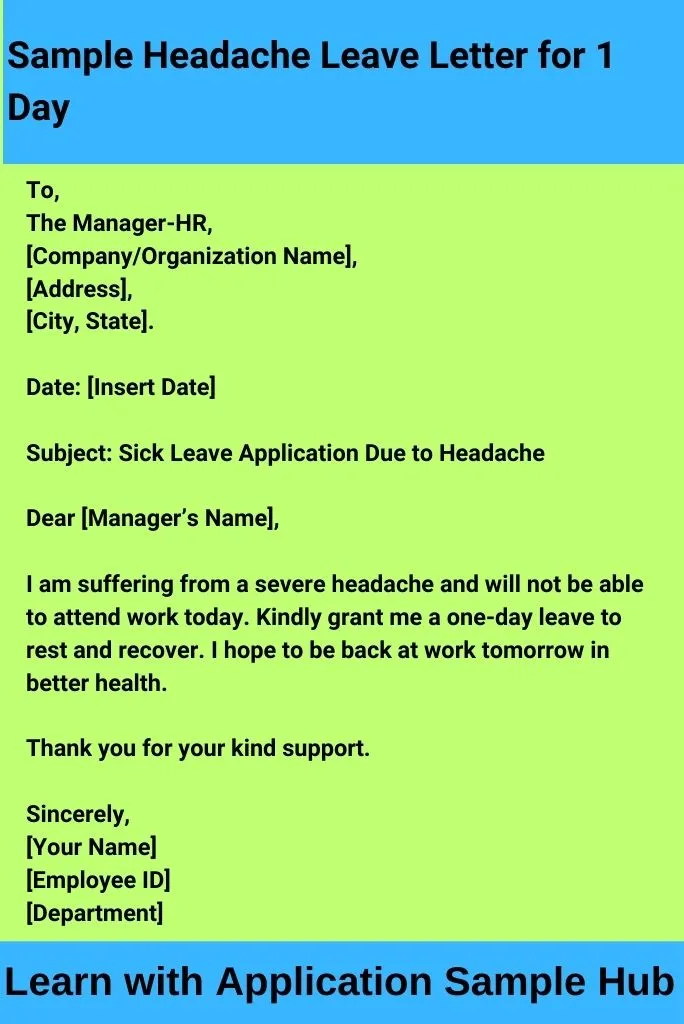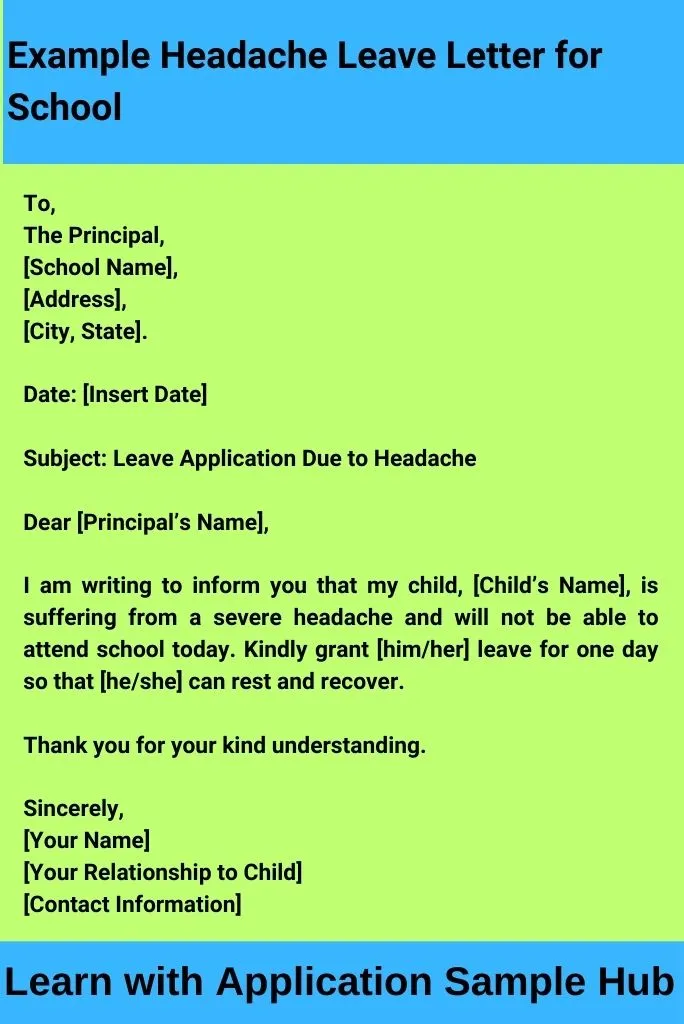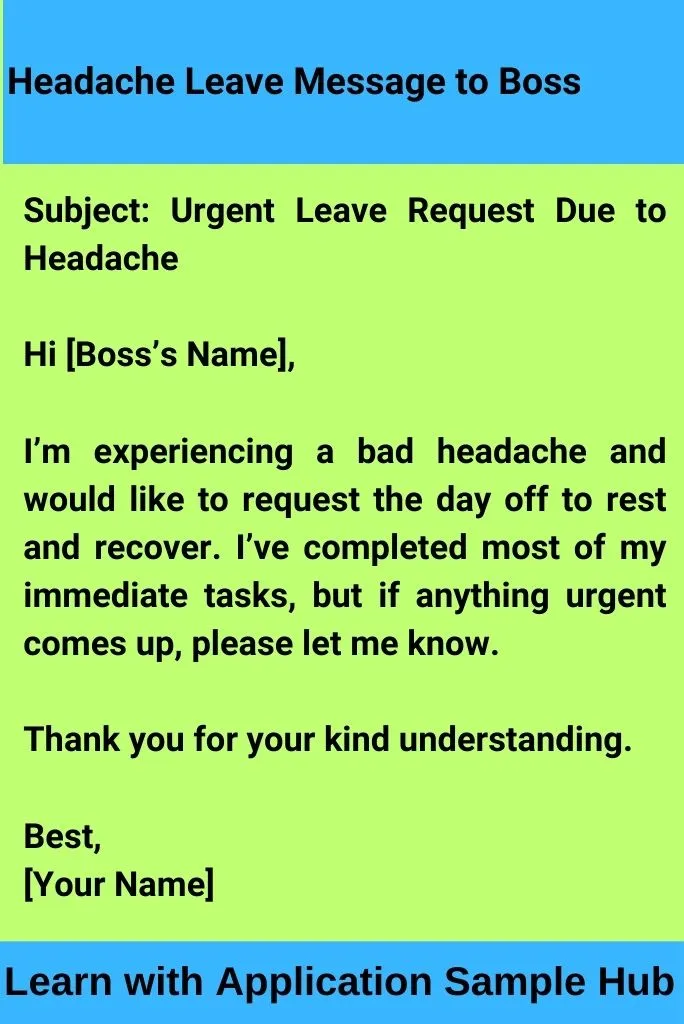Headaches can strike at the most inconvenient times, making it difficult to focus and perform at your best. Knowing how to write a Headache Leave Application for the Office can be incredibly helpful, whether it’s a sudden migraine or a persistent headache. In this article, we’ll provide 8+ sample applications for headache-related leaves, including how to ask for a half-day or full-day leave.
I’ll also cover formatting tips, components of a proper leave application, and answers to frequently asked questions (FAQs).
There’s nothing worse than trying to power through your workday while suffering from a pounding headache. Whether you’re dealing with a mild tension headache or a severe migraine, requesting time off to rest and recover can be essential for your health and well-being.
But how do you craft the perfect headache leave application for the office? In this detailed guide, we’ll explore several leave application samples for different situations, provide tips on structuring them effectively, and answer common questions about asking for headache-related leaves.
Sample Headache Leave Applications for Office

To,
The Manager-HR,
[Company/Organization Name],
[Address],
[City, State].
Date: [Insert Date]
Subject: Leave Application Due to Severe Headache
Dear [Manager’s Name],
I am writing to inform you that I am experiencing a severe headache and, as a result, will not be able to attend work today. I kindly request you to grant me a day’s leave so that I can rest and recover.
Thank you for your kind understanding.
Sincerely,
[Your Name]
[Employee ID]
[Department]
Headache Leave Application for Half Day

To,
The Manager-HR,
[Company/Organization Name],
[Address],
[City, State].
Date: [Insert Date]
Subject: Half Day Leave Application Due to Headache
Dear [Manager’s Name],
I am writing to request a half-day leave today due to a persistent headache. I have completed most of my urgent tasks and would appreciate it if you could allow me to leave early to rest.
Thank you for your kind consideration.
Sincerely,
[Your Name]
[Employee ID]
[Department]
Sample Headache Leave Letter for 1 Day

To,
The Manager-HR,
[Company/Organization Name],
[Address],
[City, State].
Date: [Insert Date]
Subject: Sick Leave Application Due to Headache
Dear [Manager’s Name],
I am suffering from a severe headache and will not be able to attend work today. Kindly grant me a one-day leave to rest and recover. I hope to be back at work tomorrow in better health.
Thank you for your kind support.
Sincerely,
[Your Name]
[Employee ID]
[Department]
Example Headache Leave Letter for School

To,
The Principal,
[School Name],
[Address],
[City, State].
Date: [Insert Date]
Subject: Leave Application Due to Headache
Dear [Principal’s Name],
I am writing to inform you that my child, [Child’s Name], is suffering from a severe headache and will not be able to attend school today. Kindly grant [him/her] leave for one day so that [he/she] can rest and recover.
Thank you for your kind understanding.
Sincerely,
[Your Name]
[Your Relationship to Child]
[Contact Information]
Headache Leave Message to Boss

Subject: Urgent Leave Request Due to Headache
Hi [Boss’s Name],
I’m experiencing a bad headache and would like to request the day off to rest and recover. I’ve completed most of my immediate tasks, but if anything urgent comes up, please let me know.
Thank you for your kind understanding.
Best,
[Your Name]
Sick Leave Application from Office Due to Headache

To,
The Manager,
[Company/Organization Name],
[Address],
[City, State].
Date: [Insert Date]
Subject: Sick Leave Request Due to Headache
Dear [Manager’s Name],
I am currently suffering from a debilitating headache and will not be able to perform my duties effectively today. I kindly request you to grant me sick leave for the day.
I hope to return to work once I feel better.
Sincerely,
[Your Name]
[Employee ID]
[Department]
How to Apply for Migraine Leave in Office

For individuals who suffer from migraines, it’s important to explain the situation to your employer in a way that highlights the severity of your condition:
To,
The Manager-HR,
[Company/Organization Name],
[Address],
[City, State].
Date: [Insert Date]
Subject: Leave Request Due to Migraine
Dear [Manager’s Name],
I am experiencing a migraine attack and will not be able to perform my duties today. I kindly request you to grant me sick leave for the day to recover from the pain and discomfort.
Thank you for your kind understanding.
Sincerely,
[Your Name]
[Employee ID]
[Department]
How to Ask for Leave for Headache
If you’re wondering how to ask for leave due to a headache, here’s a simple approach:
- Be Honest and Clear: Clearly state that you are suffering from a headache.
- Mention the Duration: Let your employer know how long you expect to be absent.
- Offer to Complete Urgent Work: If possible, mention that you’ll ensure important tasks are handled before your leave.
Example:
“Hi [Manager’s Name], I am experiencing a severe headache and will not be able to work today. Please grant me a sick day, and I will make sure to complete any pending tasks once I return.”
Components of a Proper Headache Leave Application
When writing a headache leave application, it’s crucial to include certain key components to ensure your request is clear and professional:
- Recipient Information: Include the name of the person you’re addressing (e.g., your manager or HR department).
- Date: Always include the date of writing the application.
- Subject Line: A brief and clear subject, such as “Leave Application Due to Headache.”
- Reason for Leave: Clearly state that you’re suffering from a headache or migraine.
- Duration of Leave: Specify whether you’re requesting a half-day, full-day, or more.
- Closing: End with a polite closing statement and include your contact information.
Structuring the Proper Application Effectively
To ensure your headache leave application is well-received, you should:
- Use a Clear Subject Line: A simple subject like “Leave Application Due to Headache” makes it easy for your employer to understand the reason for your leave.
- Be Polite and Concise: Explain the situation without going into unnecessary details.
- Offer a Plan (if applicable): Mention how you will manage pending work or if someone else can cover for you during your absence.
- End with Gratitude: Always thank the recipient for their understanding and support.
Tips and Best Practices for Writing a Headache Leave Application
- Be Prompt: Inform your employer as soon as possible to ensure smooth workflow management.
- Keep it Simple: Use straightforward language without over-explaining your situation.
- Mention Any Contingencies: If possible, let your employer know how your work will be handled in your absence.
- Avoid Guilt: Taking time off for your health is important, so don’t feel bad about requesting a sick day.
FAQs
How soon should I apply for leave due to a headache?
You should apply for leave as soon as you experience a headache or migraine that is severe enough to impact your work. Ideally, inform your employer at the start of the day.
Can I take a half-day leave for a headache?
Yes, if your headache improves over the day, you can request a half-day leave to recover in the morning or leave work early.
Do I need a doctor’s note for a headache leave?
In most cases, a simple leave application will suffice. However, if your company has specific policies requiring a doctor’s note, you should comply.
Can I send a leave request via text message?
Yes, you can send a headache leave request via text or email, especially if it’s urgent. Just ensure the message is polite and professional.
